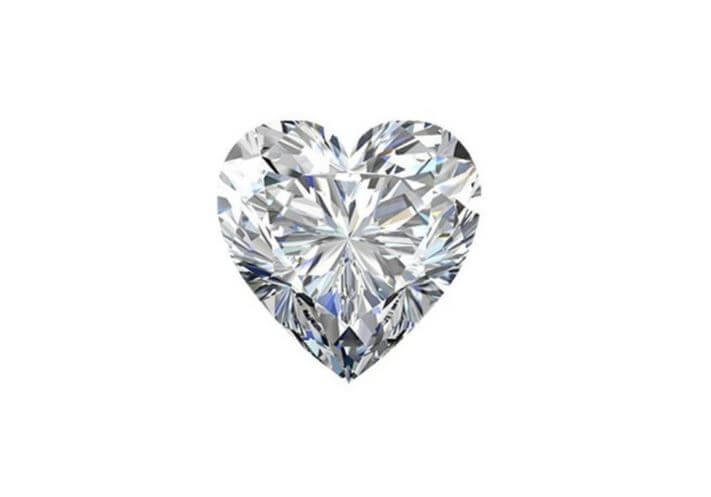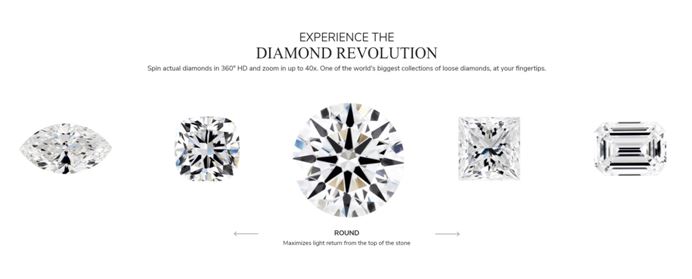Introduction
Since the inception of time, heart shape has always been a symbol of love. It is no wonder that out of the many diamond shapes there are, the heart cut remains a highly sought after diamond shape especially for engagement rings and pendants.
That notwithstanding, the rarity of this shape makes it hard to come by and more expensive than the average cut shape. This is because cutting the diamond into a heart requires meticulous skill only talented cutters possess. For this reason, the heart shape diamond has been in oblivion for the better part of the centuries until recently when technologies have made it easier to cut it. Nonetheless, the heart cut diamond first appeared in the 17th century on a portrait painting named “The Gonzaga Princess.” The popularity of the heart cut diamond surges and rises in waves. It is therefore not always available on-demand and may sometimes require custom orders.
Being that as it may, the heart cut diamond is a brilliant-cut whose shape resembles a heart. For this shape to be distinct and clear, the cleft in the middle must be distinct and unique when viewed from the top. The wings on either side should be well rounded, symmetrical, and the heart point at the end should be sharp.
Adapted from a pear shaped diamond, the heart cut diamond should have between 56-58 facets and a length to width ratio of at least 1. However, this preference varies depending on each buyer. It should be noted that a heart cut diamond of more than 0.5 carats is the best choice since the shape can be hard to conceive with smaller diamonds. If you prefer a smaller diamond, having your diamond set on a three-prong setting is ideal to avoid obscuring the shape.
Heart cut diamonds are most preferred for engagement rings because, frankly, what speaks love than a heart-shaped diamond? In such a case, a well-rounded shape with an L/W Ratio of 1.00 is the best choice. Heart cut diamonds are also common on pendants with a slight preference for narrower diamonds.
Summary
The beauty and quality of a heart shaped diamond can be evaluated using its cut grade. The cut grade is a unique set of attributes as determined by the Gemotology Institute of America that describe values and measurements of excellent cut diamonds. These are all determined in a laboratory to give the diamond the most brilliance and appealing look. However, the buyer’s tastes and preferences still take center stage when it comes to buying a heart cut diamond. There are five aspects to a diamond’s cut grade:
- The Table – The flat surface on the topmost area with the heart shape is known as the table. This is where most of the brilliance of the diamond comes through. To determine the cut grade of the diamond, the width of the table is divided by the diameter of the girdle to obtain a ratio. According to the Gemotology Institute of America, the best table ratio is between 53% and 63%.
- The girdle – This is the outer most edge around the diamond. It is what gives the diamond its shape. It can either be classified as thin, slightly thin, thick, or extremely thick. An extremely thin girdle is susceptible to chipping while a thick one adds unnecessary depth and weight on the diamond. The girdle can also be smooth, rough or faceted. Since it’s usually hidden when engraved on jewelry, its effect on the cut grade is minimal.
- The depth – The depth of the diamond is its height from the table to the culet. If you’d like your heart cut diamond to appear large when viewed from the top, then a shallow depth is preferred. However, the caveat to this is that your diamond will be less brilliant. The depth is used to determine the cut grade of the diamond by dividing it with the width and obtaining the ratio. According to the GIA, the best depth ratio of the heart-cut diamond is between 58% and 62%.
- The culet – The culet is the furthest sharp point at the bottom of a diamond. It may be pointed or faceted. A small pointed culet will maximize the brilliance of the diamond. This is because the light is trapped inside the diamond and reflected out. A diamond with a large depth should have a small pointed culet to retain as much light as possible
- Length/Width ratio – This is a ratio used to determine how narrow or wide the heart shape will be. The longest side is divided with the shortest side. For the heart cut diamond, a ratio of 0.95 – 1.02 is considered an excellent cut by the GIA. However, your tastes and preferences will dictate this.
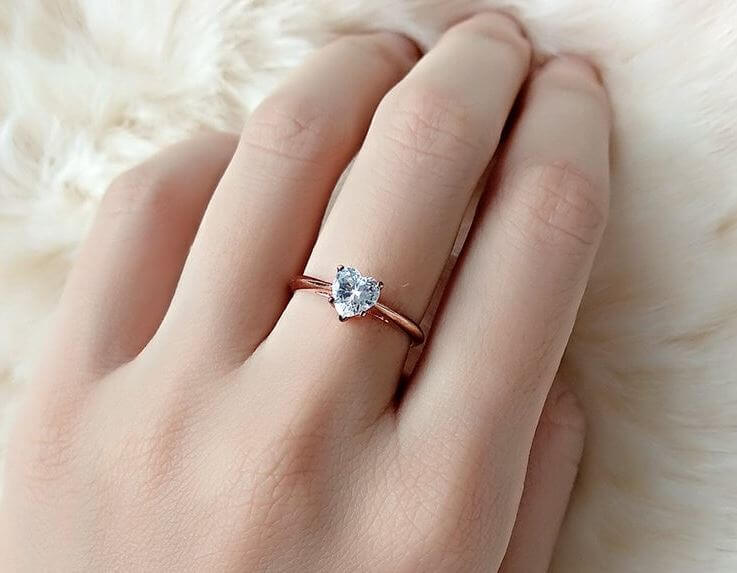
The cut grade of Heart Cut Diamond
The cut grade is a set of attributes used to determine the appeal of a diamond. Usually, they’re measurements that have been tested and proven to exemplify the diamond’s quality and brilliance.
Each cut shape of a diamond has its own set of required measurements to maximize its brilliance and beauty. The Gemological Institute of America has done intensive research and experiments to determine these measurements and is hence the most widely used source of these measurements.
Owing to the fact that the heart cut diamond is hard to come by due to the extreme difficulty of cutting it, it becomes almost inevitable to evaluate its cut grade more objectively to get the best deal. Several factors of a diamond are used to determine its cut grade. These include:
- Table
- Girdle
- Depth
- Culet
- Length/Width ratio
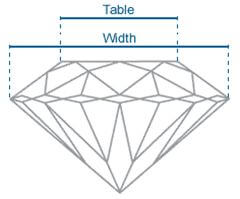
1. The Table
The table is the topmost upper flat surface of a diamond from where most of its brilliance is seen. To determine the cut grade using the table, the length of the table is measured and divided with the width of the diamond (or diameter of the girdle) to determine its cut grade. For an excellent heart cut diamond, the ratio should be between 53-63%. This ratio maximizes the size of the surface area as well as the brilliance.
The larger the table, the shorter the depth of the diamond. This is because the size of the table is indirectly proportional to its depth. A shorter diamond has the advantage of reduced carat weight but an increased surface area making the diamond appear larger than a diamond of the same carat. It’s best to maximize the table’s size in relation to the depth as both affect how brilliant and large the diamond will appear.
Heart cut diamonds, just like most brilliant cut diamonds, are also subject to the bow-tie effect phenomenon. Do not select diamonds with very large tables as this may increase the bow-tie effect and reduce the brilliance of the diamond. A table ratio of more than 70% and less than 50% is considered to be of poor quality.
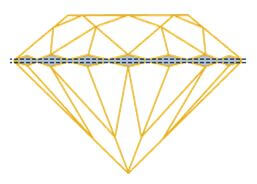
2. The Girdle
This is the outer most edge of the diamond. It gives the diamond its shape when viewed from the top. The girdle is important when it comes to evaluating the cut grade of the diamond as it determines how appealing the diamond will look. Furthermore, its size has a direct effect on the weight of the diamond and consequently, the price.
The girdle can be classified as either rough, polished, or faceted. A rough girdle is one that has not been polished. A polished one is smooth and the faceted one has facets. However, this should not worry you that much especially if the girdle will not be visible when the diamond is set. However, an extremely thin girdle can be susceptible to chipping and make your diamond appear shapeless reducing the quality of a diamond.
According to the GIA, the girdle can also be classified as extremely thin, thin, thick, and extremely thick. The main effect of the girdle is on the carat weight of the diamond. The thicker the girdle is, the more the carat weight. However, a thick girdle will give the diamond extra strength and make it less prone to chipping, unlike an extremely thin girdle.
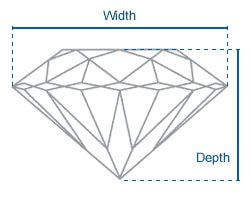
3. The depth
The depth of the diamond is its height from the table down to the culet. To determine the cut grade, the depth is taken and divided by the width of the diamond, or the longest diameter of the girdle. The ratio is then expressed as a percentage.
The best heart cut diamond has a depth ratio of between 58-62%. The GIA considers anything below 50% and above 70% as a low-quality cut.
How deep the diamond has an effect on its size and brilliance. For instance, a very deep depth will make the diamond more brilliant. However, the surface area on the table will be greatly reduced, if the carat weight is to remain the same. A shorter depth means a larger surface area, but less brilliance. You should, therefore, ensure that you maximize the depth as well as the surface area of the table to get the best deal.
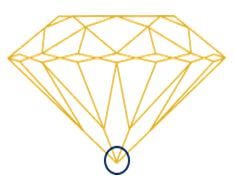
4. Culet
The culet is the sharpest point located at the bottom of a diamond. It can either be classified as none, small, medium, and large. None means that the culet is a single sharp point while large means that it’s a facet. A large culet is not desirable as it means the light will not be reflected back out but may pass through and make the diamond appear less brilliant. Even worse, it may cause inclusion in the diamond reducing its quality.
That notwithstanding, diamonds with large culets are hard to come by and most of the times, its size is negligible. You can refine your selection of the heart cut diamond by choosing the smallest culet.
5. Length/width ratio
The length/width ratio of a diamond is used to determine how narrow or wide the heart shape will be. The longest side’s length is divided by the shortest side to get the ratio. For square or round cut diamonds, the ratio is usually 1 since both sides should have the same length.
But the best L/W ratio for the heart cut diamond is considered to be 0.95 – 1.02. At this ratio, the heart shape will appear well rounded and symmetrical. But of course, tastes and preferences take precedence. This ratio is perfect for diamonds that are to be set on rings. Pendants and other settings do well with a narrower shape. However, a ratio of less than 0.80 or more than 1.15 is considered a poor cut grade for the heart cut diamond.
| Excellent | Very good | Good | Fair | Poor | |
| Table % | 53-63 | 56-57.9 Or 64-65 | 51 Or 66-68 | 50 Or 69-70 | <50 |
| Depth % | 58 – 62 | 56 – 57.9 or 62.1 – 66 | 53 – 55.9 or 66.1 – 71 | 50 – 52.9 or 71.1 – 74 | < 50 or > 74 |
| Girdle | Very Thin – Slightly Thick
| Very Thin to Thick | Very Thin to Very Thick | Ex. Thin to Ex. Thick | |
| Culet | None
| Very Small | Small | Medium | > Medium |
| L/W ratio | 0.95 – 1.02 | 0.89 – 0.94 or 1.03 – 1.05 | 0.83 – 0.87 or 1.06 – 1.10 | 0.80 – 0.83 or 1.11 – 1.15 | >0.80 or < 1.15 |
The Color
Color is highly subjective. Some people may prefer less color, others may prefer warm colors and other cool colors. It mostly depends on the buyer’s preferences. This color grade is classified by letters starting with D to H with D-F being the cool fluorescent colors and G-H being the warm colors.
Most buyers prefer the fluorescent color range driving the prices for this color range higher. However, the actual differences are unnoticeable but still effective.
The carat weight affects the color indirectly. For instance, smaller diamonds are not affected by color easily as it becomes quite hard to distinguish it. For example, a 3 carat diamond with a color grade of G will be considered good quality whereas a 0.5 carat diamond with the same color grade will be rated excellent.
Clarity
To determine the clarity of the diamond, it’s placed in a UV light emitter. An exceptional brilliant cut diamond will emit a blue light when placed under UV rays. The heart cut diamond is also subject to the bow-tie effect and it’s best to buy a diamond with minimal bow tie effect. Have your gemstone dealer test this for you.
The Bow-tie effect
When light is blocked from entering the diamond from certain angles, it causes the diamond to have a dark inclusion that resembles a man’s bowtie right in the middle. This is because there’s no light to be reflected from those angles. In effect, the diamond becomes less brilliant and in most cases, less appealing.
The bowtie effect is largely brought about by the cut. Most brilliant cut diamonds like the oval, marquise, pear, and even the heart have this phenomenon due to their shape. However, the effect can be minimized if the diamond is exemplarily cut. However, most cutters, in a bid to maximize profits, would rather retain most of the diamond’s carat weight and forego polishing the diamond to reduce the bowtie effect.
But the bow-tie effect can be used to your advantage to add some high appeal to the diamond. However, avoid large bowties as they may not be beautiful to look at.
The Carat Weight
The carat is the main unite of weight measurement for diamond. It is an equivalent of 0.2 grams and can be further subdivided into 100 units. The carat only measures the weight. It does not measure other aspects of the diamond-like the brilliance, the cut, the color or other aspects. So it should be approached with a caveat.
Unfortunately, the carat gets thrown around when talking about diamonds like the most important factor to consider. It shouldn’t be unless you’re only concerned by the size of the diamond and not it’s quality. You might as well just buy a rough stone. In fact, the majority of the low priced diamonds with large carats have poor cut grade. This is because large diamonds are rarer and larger carat weight will most likely be higher priced compared to a smaller one. The carat weight becomes important depending on the jewelry you plan on using the diamond.
